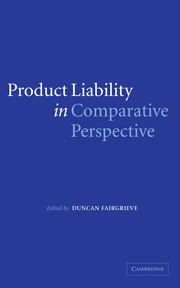Book contents
- Frontmatter
- Contents
- List of figures
- Foreword by Sir Michael Burton
- List of contributors
- Preface
- 1 Introduction
- PART I Country reports
- PART II European influences
- 9 Product liability: basic problems in a comparative law perspective
- 10 The development risks defence
- 11 Approaches to product liability in the EU and Member States
- 12 Product liability – a history of harmonisation
- PART III Comparing systems
- Appendix
- Index
12 - Product liability – a history of harmonisation
from PART II - European influences
Published online by Cambridge University Press: 28 July 2009
- Frontmatter
- Contents
- List of figures
- Foreword by Sir Michael Burton
- List of contributors
- Preface
- 1 Introduction
- PART I Country reports
- PART II European influences
- 9 Product liability: basic problems in a comparative law perspective
- 10 The development risks defence
- 11 Approaches to product liability in the EU and Member States
- 12 Product liability – a history of harmonisation
- PART III Comparing systems
- Appendix
- Index
Summary
Introduction
Rather than discussing whether harmonisation of product liability is desirable or practical or debating how best it can be achieved, this chapter deals with a topic (product liability), which has in fact, since 1985, been the subject of a harmonising directive. This chapter seeks to focus on three issues. First, what has the product liability experience taught us about the need for harmonisation and particularly about the degree of harmonisation required for internal market reasons? Second, how has the Community monitored its legislation and determined whether it needs to be amended? Finally, we will use the central concepts of defect and development risks to consider whether the courts (both national and European) have been able to develop a harmonised approach to interpretation and what can be done to enhance a common development of European principles.
How much harmonisation is necessary?
The Product Liability Directive was introduced as an internal market measure under art. 100 of the Treaty. The drafter of the Directive, Professor Taschner, has on many occasions subsequently spoken of his firm belief that the measure is an internal market and not a consumer protection measure. Thus the first recital to the directive states that ‘the existing divergences may distort competition’, although it does go on to note that this may entail a differing degree of consumer protection.
One unfortunate side effect of this has been that product liability has not been within the sweep of directives for which the consumer protection Directorate General (DG-SANCO) is responsible.
- Type
- Chapter
- Information
- Product Liability in Comparative Perspective , pp. 202 - 218Publisher: Cambridge University PressPrint publication year: 2005
- 1
- Cited by



